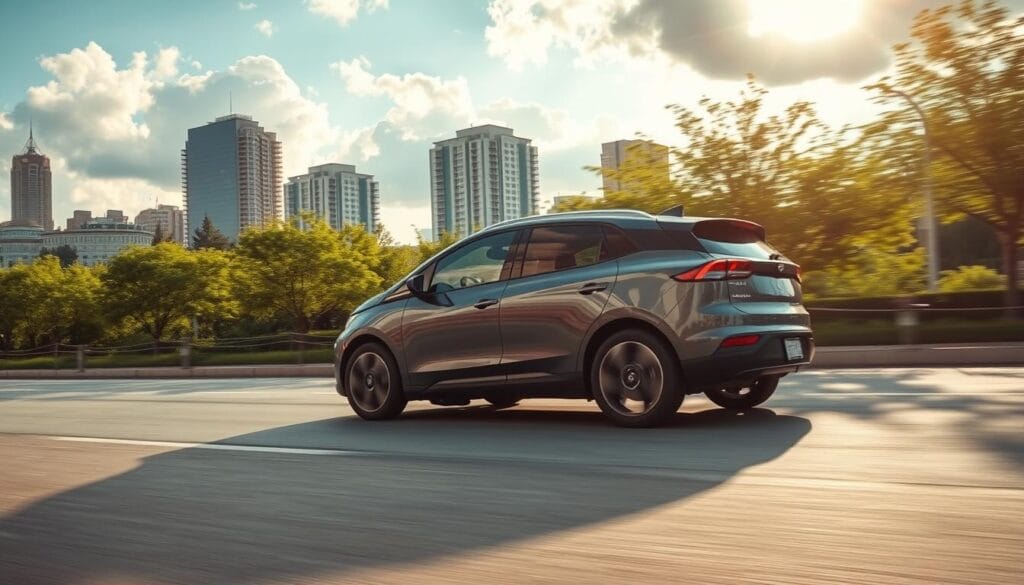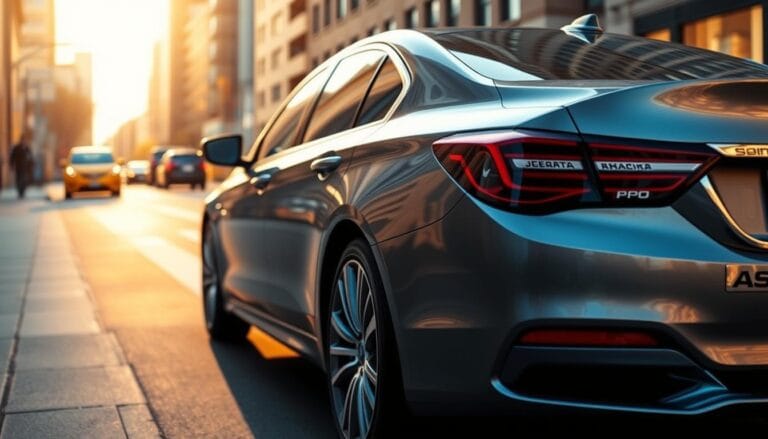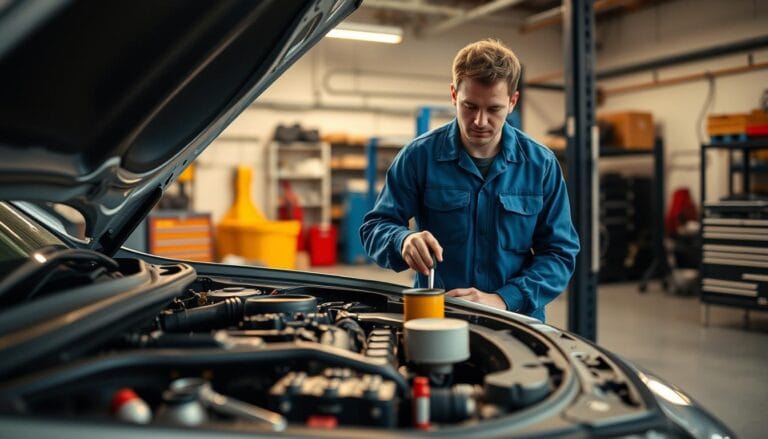Regenerative Braking Care: Optimize Efficiency in 2025
The road ahead is changing, and your electric vehicle is leading the revolution. Every time you tap the brake, you’re not just slowing down—you’re powering up. Regenerative braking technology has changed how we think about driving efficiency. It turns what was once wasted energy into a powerful resource for your electric vehicle brakes.
Imagine capturing the energy lost during braking and putting it back into your vehicle’s battery. That’s the magic of regenerative braking care. As electric vehicles evolve, understanding this technology is key for better performance and sustainability.
In 2025, regenerative braking is more than a feature—it’s a game-changer. With new advancements, your electric vehicle can now reclaim up to 25% of energy during braking. This greatly improves overall efficiency and driving range.
Table of Contents
Understanding Regenerative Braking Systems
Regenerative braking is a new tech in electric vehicles (EVs) that changes how we manage energy when slowing down. Unlike old braking methods that lose energy as heat, these systems catch and use kinetic energy. This makes EVs much more efficient.
What is Regenerative Braking?
Regenerative braking turns a car’s moving energy into electrical energy when slowing or stopping. When you remove your foot from the gas or press the brake, the EV’s electric motors turn into generators. They capture energy that would usually be lost.
- Captures kinetic energy during deceleration
- Converts motion into electrical power
- Stores energy in the vehicle’s battery
How It Works in Electric Vehicles
In electric vehicles, the electric motors do two jobs: moving the car and capturing energy. When slowing, these motors make electricity, which goes into the battery. This cuts down on energy loss and makes the car go further on a single charge.
| Vehicle Type | Energy Recovery Potencial | Efficiency Improvement |
|---|---|---|
| Tesla Model S | Over 60 kW | Up to 20% |
| Delhi Metro | 112,500 MWh (2004-2007) | 90,000 tons CO2 reduction |
| Hybrid Vehicles | Up to 70% energy recovery | 10-30% fuel efficiency |
Benefits Over Traditional Braking
EVs with regenerative braking have big advantages. They wear down brakes less, save energy, and stop smoother. Drivers get longer brake life and better car performance.
“Regenerative braking turns wasted energy into a valuable resource, making every stop an opportunity for efficiency.” – EV Technology Expert
By using regenerative braking, you can get the most out of your electric vehicle. It also helps make driving greener.
Importance of Regular Maintenance
Keeping your electric vehicle’s brakes in top shape is key for safety and performance. Regenerative braking changes how cars stop, but it needs regular checks. Electric vehicle maintenance is different from traditional car care, with its own set of challenges and benefits.
Electric cars are a big step forward in car tech, and brake care is vital for their efficiency. The new braking tech helps traditional brakes last longer, but don’t forget to keep up with maintenance.
Why Maintenance Matters
Your EV’s performance depends on regular care. Here are some important maintenance tips:
- Brake pads can last up to 100,000 miles with regenerative braking
- EVs have about 20 moving parts, compared to 2,000 in gas cars
- Drivers save around $949 a year on maintenance costs
Signs Your System Needs Attention
Look out for these signs that your brakes need a check:
- Less energy recovery when braking
- Strange sounds or vibrations when braking
- Less overall car efficiency
Regular maintenance is essential for your electric vehicle’s performance and life span.
| Maintenance Item | Recommended Interval |
|---|---|
| Brake Fluid Check | Every 2-3 Years |
| Tire Rotation | Every 6,000-8,000 Miles |
| Battery Health Assessment | Annually |
By following regular brake maintenance, your electric vehicle will stay reliable, efficient, and eco-friendly.
Key Components of Regenerative Braking
Regenerative braking is a new tech in electric vehicle brakes. It changes how energy is used when slowing down. It turns lost energy into power for your car’s battery.
Knowing about energy recovery systems is key for electric car owners. These systems need several important parts:
- Electric motors that double as generators
- High-capacity battery storage units
- Advanced power conversion electronics
- Sophisticated control mechanisms
The Role of Electric Motors
Electric motors in regenerative braking systems do two things. When you brake, they switch from moving the car to making electricity. They turn the car’s energy into electrical power for the battery.
Understanding Energy Storage Systems
The core of regenerative braking is its energy storage. Modern electric cars use advanced batteries to save up to 70% of braking energy. This makes cars more efficient, saves energy, and increases driving range.
Regenerative braking isn’t just a technology—it’s a revolution in energy management for electric vehicles.
Your electric vehicle’s regenerative braking is a mix of engineering and innovation. It makes every brake application a chance to save energy.
How to Care for Your Regenerative Braking System
Keeping your electric vehicle’s regenerative braking system in top shape is key. These systems need less upkeep than old braking systems. But, taking good care of them ensures they work well and safely.
Good care for your regenerative braking system means more than just a quick check. Knowing what your electric vehicle’s brakes need helps avoid problems. It also makes them last longer.
Regular Inspections You Should Perform
Regular brake checks are vital for your electric vehicle’s health. Here are some important ones:
- Check brake pad condition every 12,000 to 15,000 miles
- Inspect brake fluid annually for contamination
- Test parking brake functionality quarterly
- Look for signs of rust or corrosion on brake components
Recommended Service Intervals
| Maintenance Task | Recommended Interval |
|---|---|
| Brake Fluid Replacement | Every 4 years |
| Brake Caliper Lubrication | Every 20,000 kilometers |
| Comprehensive Brake Inspection | Annually |
Do-It-Yourself Maintenance Tips
Electric vehicle owners can do a lot to keep their brakes in good shape:
- Keep battery charge between 20% and 80%
- Enable automatic software updates
- Practice smooth regenerative braking techniques
- Clean brake components regularly
*Always consult your vehicle manufacturer’s specific guidelines for precise maintenance recommendations.*
By following these tips, you’ll keep your electric vehicle running smoothly and safely. Remember, it’s cheaper to prevent problems than to fix them later.
Enhancing Efficiency Through Technology
Technological advancements are changing EV braking systems. They are making electric and hybrid vehicles more efficient and powerful. New battery technologies and smart software are key to these improvements.
The way electric vehicles use energy when slowing down has changed. Thanks to new hybrid braking tech, cars can now capture and use more energy. This makes them perform better and use less fuel.
Advancements in Battery Technology
Battery tech has seen big leaps forward. Some of the main improvements include:
- Increased energy density
- Faster charging
- Better thermal management
- Longer battery life
Software Updates for Improved Performance
Over-the-air (OTA) software updates have changed the game for electric cars. These updates can greatly improve how well your car brakes:
- They make energy recovery better
- Braking feels more responsive
- They help your car go further
- They fix any bugs
These tech upgrades have a big impact. Regenerative braking can make a car up to 20% more efficient. This is great news for those who want to drive in a more eco-friendly way.
| Technology | Performance Improvement | Energy Recovery |
|---|---|---|
| Advanced Battery Systems | 15-25% increased efficiency | Up to 90% energy recapture |
| Smart Software Updates | Enhanced driving range | Real-time system optimization |
| Regenerative Braking Tech | Reduced mechanical wear | Lower maintenance costs |
The future of electric vehicle technology lies in continuous innovation and intelligent energy management.
Impact of Driving Habits on System Performance
Your driving style is key to making your electric vehicle’s brakes work better. How you drive affects how well your brakes last and how efficient they are.

Knowing how your driving habits impact your electric vehicle’s performance is important. It helps you use your battery more efficiently. Using the right driving techniques can make your regenerative braking system work better.
Eco-Friendly Driving Techniques
To improve your regenerative braking, try these driving tips:
- Drive at a smooth and consistent speed
- Anticipate traffic to avoid sudden stops
- Accelerate and brake slowly
- Keep your tires at the right pressure
- Plan your route to avoid lots of stops
Common Driving Mistakes to Avoid
Some driving habits can harm your electric vehicle’s brakes and regenerative system:
- Don’t accelerate or brake too hard
- Avoid short trips under 10 miles
- Don’t overload your vehicle
- Drive at steady, high speeds
- Don’t ignore your battery’s temperature
The National Renewable Energy Laboratory says driving smart can boost your electric vehicle’s range by up to 20%. By following these tips, you can make your regenerative braking system last longer and work better.
Diagnosing Common Issues
Keeping your vehicle’s brakes in top shape is key. You need to watch for warning signs. Regenerative braking systems are complex and need careful checks to work right.
Spotting problems early can save you money and keep you safe. ABS sensor checks are vital for finding issues before they get worse.
Signs of System Malfunction
- Unusual braking performance or reduced stopping power
- Persistent warning lights on the dashboard
- Unexpected noises during deceleration
- Inconsistent regenerative braking response
- Vibrations during braking
Diagnostic Tools for Brake System Maintenance
Modern electric cars have advanced diagnostic tools. These tools help find issues fast. Professional tools give detailed info on your braking system’s health.
| Diagnostic Tool | Primary Function | Estimated Cost |
|---|---|---|
| OBD-II Scanner | Reads error codes and system status | $50-$200 |
| Multimeter | Tests electrical components and sensor functionality | $20-$100 |
| Specialized EV Diagnostic Software | Comprehensive system analysis | $100-$500 |
If you see ongoing problems, get a pro who knows electric and hybrid brakes. Catching issues early can avoid big, costly fixes later.
Professional tip: Regular diagnostic checks can help you identify problems before they become serious safety concerns.
The Future of Regenerative Braking
Electric vehicle technology is growing fast, with EV braking systems leading the way. The next step in hybrid braking technology will change how we manage vehicle energy.
New trends in regenerative braking will change electric vehicle performance. Car makers are working on new ways to improve energy recovery and efficiency.
Emerging Trends to Watch
- Energy recovery rates could go up from 70% to even more
- Advanced software for better energy capture
- Lighter, more compact braking systems
- Better battery integration for smoother energy use
The Role of Autonomous Vehicles
Autonomous vehicles are key for EV braking systems. They need precise regenerative braking for:
- Better energy recovery
- Smooth integration with self-driving tech
- Quick responses in complex driving situations
The future of regenerative braking is not just about stopping vehicles—it’s about transforming how we think about energy efficiency in transportation.
As technology advances, we can expect regenerative braking systems to become increasingly intelligent, adaptive, and energy-efficient.
Environmental Benefits of Regenerative Braking
Electric vehicle technology is changing how we travel. Regenerative braking is a key part of this change. It offers big benefits for the environment, unlike old braking methods.

Reducing Carbon Footprint with EVs
Electric vehicle brakes use energy recovery systems. These systems can catch up to 70% of kinetic energy lost when braking. This makes electric vehicles much more efficient.
- Reduces greenhouse gas emissions by up to 20%
- Extends vehicle driving range by 10-30%
- Decreases brake component wear by 50%
Contribution to Sustainable Transportation
Electric vehicles with regenerative braking are great for the planet. In cities, they can catch back up to 80% of energy lost during braking.
| Environmental Metric | Regenerative Braking Impact |
|---|---|
| Energy Recovery Efficiency | Up to 90% |
| Brake Maintenance Cost Reduction | Approximately 30% |
| Tailpipe Emissions | Significantly Reduced |
Electric vehicles are getting better at using renewable energy. They’re making a big difference in reducing our carbon footprint.
Regenerative Braking in Different Vehicles
Regenerative braking has changed how vehicles use energy when slowing down. EV braking systems have become more advanced. This has changed how different vehicles save energy.
Hybrid braking technology is great for saving energy in many vehicles. How well it works depends on the vehicle’s design and use.
Applications in Electric Cars
Electric cars show the best use of regenerative braking. They can turn up to 70% of braking energy back into power. This makes them very efficient.
- High-performance EVs can regenerate up to 265 kW of energy
- Multiple regenerative braking levels allow for customized driving experiences
- One-pedal driving becomes possible with advanced EV braking systems
Use in Public Transportation
Public transport vehicles use regenerative braking very well. Buses and trains can use less energy thanks to advanced braking tech.
- Urban buses can recover energy during frequent stops
- Train systems capture significant energy during deceleration
- Large vehicles benefit from increased efficiency up to 30%
Public transport can save a lot of energy. Regenerative braking systems can reduce brake maintenance costs by approximately 25% over a vehicle’s lifetime. This makes them a smart choice for transit agencies.
Regenerative braking is not just a technology—it’s a sustainable approach to transportation that reimagines how we use energy.
Cost-Effectiveness of Regenerative Braking Care
Electric vehicle owners are finding big savings with regenerative braking care. By keeping up with brake system maintenance, you can save a lot of money. Plus, your vehicle will run better.
Regenerative braking is a big money-saver for electric vehicle owners. EV owners might spend 50-60% less on upkeep than those with gas cars.
Long-Term Financial Savings
Your regenerative braking system offers many financial perks:
- Less wear on brake parts
- Lower upkeep costs
- A longer vehicle life
- Better energy use
Incentives for Electric Vehicle Owners
Electric vehicle owners get several financial perks to help with regenerative braking care costs:
- Federal tax credits for EVs
- State rebates for electric cars
- Warranties from manufacturers
- Discounts on maintenance programs
The tech can grab back up to 70% of kinetic energy when slowing down. This means big energy savings. Proper care of your regenerative braking system boosts these savings and helps the planet.
Smart maintenance today means significant savings tomorrow.
Regular brake system upkeep keeps your electric vehicle efficient, affordable, and eco-friendly.
Conclusion: Your Role in Optimizing Regenerative Braking
Regenerative braking care is key for electric vehicle owners today. Knowing how energy recovery systems work helps you use your car more efficiently. This way, you help the planet too.
By taking care of your regenerative braking, you make your car last longer and use less energy. Car makers like Toyota, Kia, and Hyundai are using these systems more. They help save money on repairs and are better for the environment.
Taking Action for Efficiency
Regular maintenance and knowing your car’s regenerative braking can save up to 15% of your range. This means you use less electricity and save money. By driving smart, checking your car often, and keeping up with new tech, you get the most out of your car.
Staying Informed About Innovations
The world of electric cars is always changing. Staying up-to-date with new regenerative braking tech is important. It makes your driving better and helps the planet too.







